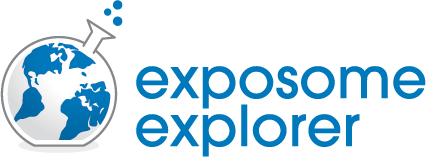Related databases
Chemicals
| PubChem | PubChem is a freely available database of chemical structures of small organic molecules and information on their biological activities. It contains structure, nomenclature, and calculated physicochemical data and is linked with the United States National Institutes of Health (NIH) PubMed/Entrez information. PubChem is organized as three linked databases within the United States National Center for Biotechnology Information (NCBI) Entrez information retrieval system. These are PubChem Substance, PubChem Compound, and PubChem BioAssay. PubChem also provides a fast chemical structure similarity search tool. There are > 19 million unique chemical structures in the PubChem database. |
| HMDB | The Human Metabolome Database (HMDB) is a freely available electronic database containing detailed information about small molecule metabolites found in the human body. It contains experimental mass spectrometry/mass spectrometry (MS/MS) data for 800 compounds, experimental 1H and 13C nuclear magnetic resonance (NMR) data (and assignments) for 790 compounds, and gas chromatography/mass spectrometry (GC/MS) spectral and retention index data for 260 compounds. In addition, predicted 1H and 13C NMR spectra have been generated for 3100 compounds. All spectral databases are downloadable and searchable. |
| ChEBI | Chemical Entities of Biological Interest (ChEBI) is a freely available dictionary of molecular entities focused on “small” chemical compounds. The chemical entities in ChEBI are either products of nature (metabolites) or synthetic products used to intervene in the processes of living organisms (drugs or toxins). ChEBI contains structure and nomenclature information along with hyperlinks to many well-regarded databases. ChEBI uses a carefully developed ontological classification, whereby the relationships between molecular entities or classes of entities and their parents and/or children are precisely specified. ChEBI has > 15 500 chemical entities in its database. |
Nutrition
| FooDB | FooDB is the world’s largest and most comprehensive resource on food constituents, chemistry, and biology. It provides information on both macronutrients and micronutrients, including many of the constituents that give foods their flavour, colour, taste, texture, and aroma. |
Environment
| ExpoCastDB | ExpoCastDB is part of the Aggregated Computational Toxicology Resource (ACToR) system developed by the United States Environmental Protection Agency (EPA). It contains human exposure data from observational studies and currently houses results for a set of studies funded by EPA’s National Exposure Research Laboratory (NERL). Data include amounts of study chemicals found in food, drinking water, air, dust, indoor surfaces, and urine. |
| HSDB | The United States National Library of Medicine (NLM) Hazardous Substances Data Bank (HSDB) is a toxicology database that focuses on the toxicology of potentially hazardous chemicals. It provides information on human exposure, industrial hygiene, emergency handling procedures, environmental fate, regulatory requirements, nanomaterials, and related areas. The information in HSDB has been assessed by a scientific review panel. |
| IPCS | The International Programme on Chemical Safety (IPCS) provides rapid access to internationally peer-reviewed information on chemicals commonly used throughout the world, which may also occur as contaminants in the environment and in food. It consolidates information from a number of intergovernmental organizations whose goal it is to assist in the sound management of chemicals. |
| MEB-Labs | The Measuring Environmental Biomarkers - Laboratories (MEB-Labs) searchable database contains information about laboratories capable of measuring exposure biomarkers, offered as a resource to the community of environmental scientists. Data elements include the laboratory name, location, contact information, link to website, chemical biomarkers measured, analytical technique, limits of detection, and laboratory publications. |
Toxicology
| ACToR | Aggregated Computational Toxicology Resource (ACToR) is EPA’s online warehouse of all publicly available chemical toxicity data and can be used to find all publicly available data about potential chemical risks to human health and the environment. ACToR aggregates data from > 1000 public sources on > 500 000 chemicals and is searchable by chemical name and other identifiers. |
| CTD | The Comparative Toxicogenomics Database (CTD) provides manually curated information about chemical-gene/protein interactions, and chemical-disease and gene-disease relationships. These data are integrated with functional and pathway data to aid in development of hypotheses about the mechanisms underlying environmentally influenced diseases. CTD also contains concentrations of chemicals in environmental and biological matrices. |
| T3DB | The Toxin and Toxin-Target Database (T3DB) is a database of common toxins and their associated toxin targets. It contains detailed target and compound information similar to DrugBank, including structure, properties, mechanism of action, gene/protein sequence, and associated single nucleotide polymorphisms (SNPs). |
| EDKB | The Endocrine Disruptor Knowledge Base (EDKB) is intended to serve as a resource for research and regulatory scientists to categorize chemicals according to potential risks for endocrine activity, foster the development of computational predictive toxicology models, and reduce dependency on slow and expensive animal experiments. It contains data from different in vitro assays, including estrogen receptor binding, androgen receptor binding, uterotropic activity, cell proliferation, and reporter gene assays. |
Other databases
| DrugBank | The DrugBank database is a blended bioinformatics and cheminformatics resource that combines detailed drug (i.e. chemical, pharmacological, and pharmaceutical) data with comprehensive drug target (i.e. sequence, structure, and pathway) information. The database contains nearly 4800 drug entries, including > 1350 FDA-approved small molecule drugs, 123 United States Food and Drug Administration (FDA)-approved biotech (protein/peptide) drugs, 71 nutraceuticals, and > 3243 experimental drugs. DrugBank also contains extensive SNP-drug data, which are useful for pharmacogenomics studies. |
| IARC Monographs on the Identification of Carcinogenic Hazards to Humans | The IARC Monographs identify environmental factors that can increase the risk of human cancer. These include chemicals, complex mixtures, occupational exposures, physical agents, biological agents, and lifestyle factors. |

